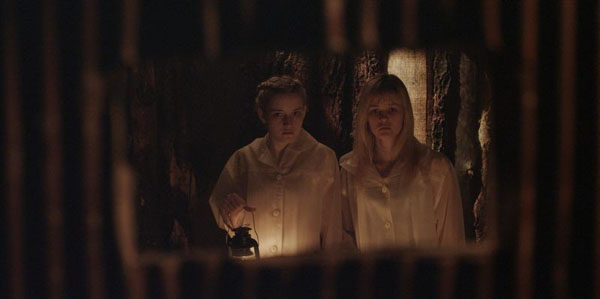With a fresh clip released in the run-up to next week’s Directors’ Fortnight screenings, here’s a sampling of the reviews that appeared when the horror remake premiered at Sundance in January.
“In the deliciously seasoned genre treat We Are What We Are, director Jim Mickle and his screenwriting partner Nick Damici take the bones of the 2010 Mexican film of the same name, about a family of ritualistic cannibals, and reassemble them into an entirely different creature,” wrote David Rooney for the Hollywood Reporter. “Exchanging impoverished urban anxiety for rural creepiness in upstate New York, this reimagining serves up chilling contemporary American Gothic that slowly crescendos into an unexpected burst of gloriously pulpy Grand Guignol. You may never look at a bowl of beef stew the same way again.”
James Rocchi, who interviewed Mickle and Damici for MSN, found that the team “has kept faith with [Jorge Michel] Grau’s original while placing his own moody, atmospheric stamp on the film. This is not to suggest that We Are What We Are is short on gore—indeed, when the crimson and carnage comes, it does so in gouts and gobbets, blood flowing and flesh flying—but, rather, to suggest that Mickle is as concerned with the people committing these atrocities as he is with the people they affect, painting a portrait of a family wracked by a semi-religious tradition, passed down from generation to generation, that requires feasting on one of ‘the Lambs’ that God provides them each year.”
“Mickle and Damici’s first two films, Mulberry Street and Stake Land, both riffed on standard-issue horror subjects—deadly viruses and vampires, respectively—to engagingly eccentric effect, so it should come as no surprise that they play fast and loose with their source material here,” wrote Guy Lodge in Variety. “Where the original tilted into frenzied urban chaos as the family’s flesh-starved offspring set about finding suitable victims, the new film hits a stealthier stride, locating the most crucial conflict in the family itself: Dad (Bill Sage) is the enemy, while angel-faced daughters Iris (Ambyr Childers) and Rose (Julia Garner) want out of their not-so-proud family tradition, implied here as having 18th-century religious origins. Kelly McGillis, who also was featured in Stake Land, provides some welcome warm notes as the children’s prying neighbor and would-be protector.”
“Outdoing the original by a long shot, Mickle’s slow-burn take on the story is poetic, creepy and, finally, satisfyingly gross,” wrote Indiewire‘s Eric Kohn. “Make no mistake: Mickle wants to make you jump and scream, but death only arrives in this movie once its world comes to life, which makes each sudden turn all the more intense.”
For Ioncinema‘s Nicholas Bell, though, the original is “vastly superior.” More from Kim Voynar (Movie City News; spoiler alert) and John Wildman (Film Comment). And Indiewire‘s got a few words with Mickle.
Update, 5/16: Anne Thompson introduces an interview with the filmmaker: “Raised in rural Pennsylvania without much access to movie theaters, writer-director Mickle is a horror film fanatic who has supported himself as a jack of all trades since graduating from NYU Film School, doing corporate videos and low budget films, often with rookie directors, as a grip or storyboard artist. He’s yet another example of today’s DIY ethic, as groups of would-be filmmakers pull together to help each other make low-end HD movies.”
Update, 5/17: “Memento Films International (MFI) has launched sales on a prequel and a sequel,” reports Melanie Goodfellow for Screen. “Finnish filmmaker AJ Annila, best known for genre pictures Sauna and Jade Warrior, has signed to direct the prequel What We Were. It will be his first English-language film. Mexican director Jorge Michel Grau, who made the original film Somo Lo Que Hay, has agreed to do the sequel. He is currently developing a treatment for a 2014 shoot.”
Update, 5/22: A “great yarn, well-acted, elegantly shot and put together cleverly so that even its more visceral delights feel well-earned,” finds Jessica Kiang at the Playlist.
Update, 5/23: Writing for the Notebook, Marie-Pierre Duhamel finds all the praise “totally deserved… For the viewer, melancholy here is also ‘the pleasure of being sad’ (V. Hugo). Melancholy as a disease provoked by the original sin and as the characteristic of those who wish to know and think more may be what the film conveys as much as what the characters experience.”
Update, 5/24:
Interview de Jim Mickle & Julia Garner from Quinzaine des Réalisateurs on Vimeo.
Update, 6/1: Indiewire‘s Eric Kohn interviews both Mickle and Grau.
Cannes 2013 Index. And you can watch over 100 films that have seen their premieres in Cannes right here on Fandor. For news and tips throughout the day every day, follow @KeyframeDaily on Twitter and/or the RSS feed. Get Keyframe Daily in your inbox by signing in at fandor.com/daily.




